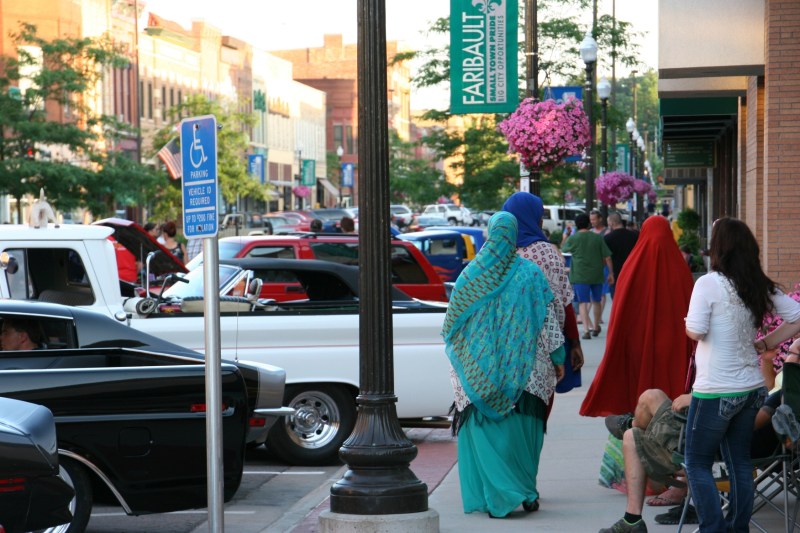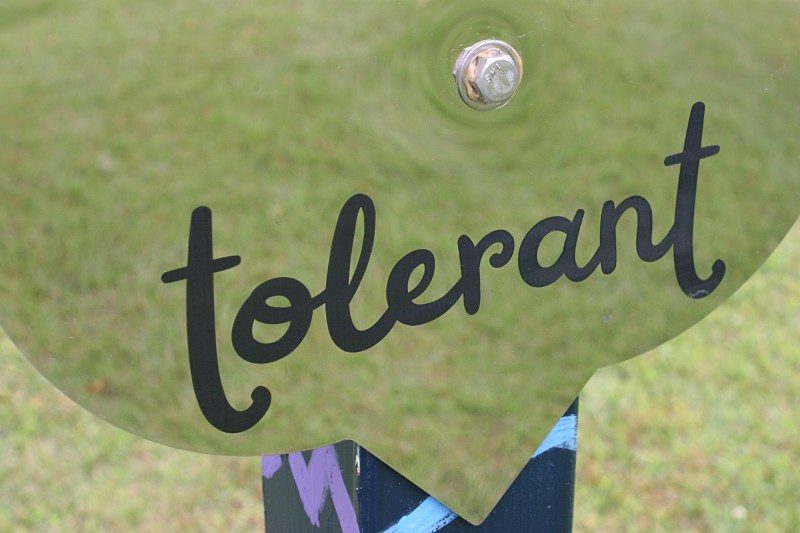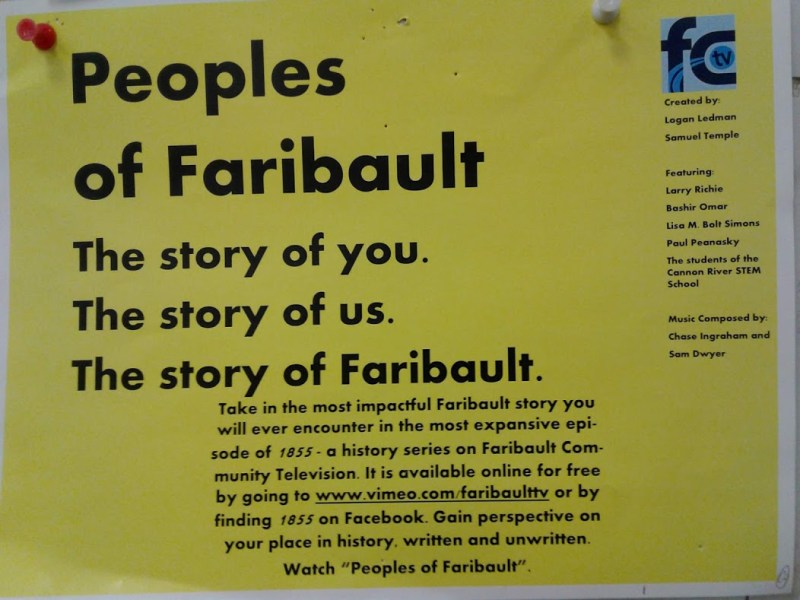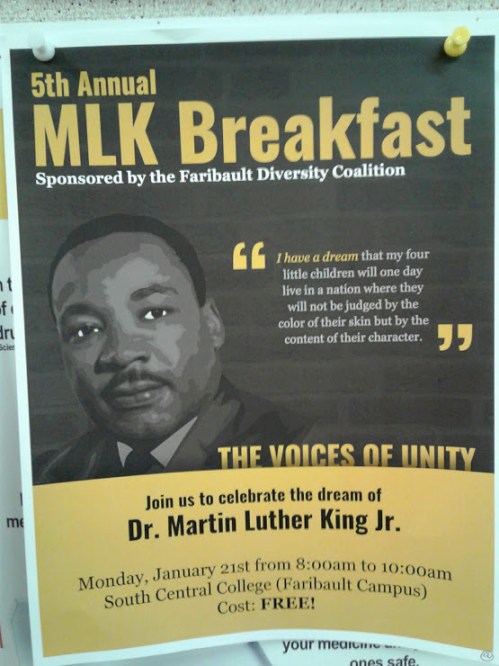
I took this photo, reflecting Faribault’s diversity, during a downtown event several years ago. Minnesota Prairie Roots file photo.
FARIBAULT IS A COMMUNITY EVOLVING. Changing as our population diversifies and we are no longer a place of mostly European and Scandinavian peoples. Rather, my southeastern Minnesota city is now home to people of many colors. We are increasingly diverse.

1960s vintage art that represents, to me, the colorful and beautiful diversity of my community. Minnesota Prairie Roots file photo.
An article published last week in the Faribault Daily News stated that from 2010 to 2018, the population of students of color in the Faribault School District increased from 25 percent to 55 percent. That’s a remarkable change in just eight years.

Faribault Community School is hosting two more Harboring Voices Choir evenings on January 22 and 29. Led by St. Olaf College students, the gathering gives adults and kids an opportunity to sing together in a community setting.
Equally as remarkable is the shift I’ve noticed in attitudes, in efforts to welcome our newest families. I’m hearing fewer negative comments about Somalis, Hispanics and other immigrants. I’m not saying those attitudes don’t still exist. It’s just that I don’t hear that animosity as much or sense such strong resentment toward these newcomers.
Why the change?

One of the virtues highlighted as part of The Virtues Trail Project. Minnesota Prairie Roots file photo August 2018.
After time, people become more accepting as they adjust and as newcomers assimilate into the fabric of Faribault. I think much of that can be attributed to the kids, who see their classmates as classmates and friends, not defined by their skin color.

This notice is posted, among the one above and the one below, on a community bulletin board at Buckham Memorial Library, Faribault.
But adults have also made concerted efforts to help locals and newcomers accept one another. The Virtues Project Faribault, the Faribault Diversity Coalition, Faribault Community School and the creators of 1855, a local history series on Faribault Community Television, are all making a difference. I am grateful for their efforts.
My great grandparents emigrated from Germany to America. They faced challenges in language, culture and more. It’s important to remember our immigrant roots. But no matter our ethnicity, our language, our culture, our skin color, we are all just people…with hopes and dreams. And voices.
© Copyright 2019 Audrey Kletscher Helbling


Good post for MLK weekend and everyday.
That’s exactly why I chose to publish this post today. And, yes, this is fitting for every day also.
Bravo!!! The United States was built by immigrants. Just because our ancestors maybe came to this Country years ago, we don’t have to right to bar others from trying to make a better life for themselves and their families.
I absolutely agree.
We have to be careful not to define diversity in terms of skin color, accent, food and clothing. The critical challenge is values.
People from other places have wildly different values and the true test of tolerance is learning to deal with them and where to draw the line that demands that immigrants adopt our values.
Things like child marriage, genital mutilation, interaction between genders and generations and absolute fidelity to family over community are stark examples of some of the issues we have faced as a result of welcoming people from distant lands.
There are two dangers to this kind of diversity: we reject them or they reject us. The United States has done a fairly good job of integrating large immigrant populations, while other places like Northern Europe have failed totally resulting in isolated ghettos and no-go zones.
I don’t know what the solution is but there is no magic. Our success in the past can portent success in the future or it can break down – and if that happens, you don’t want to think about it.
Almost Iowa, I certainly agree with you on your comments. The baseline of American (as we understand it) culture even breaks down into minor or sub-cultures within communities or even in parts of major cities. I would hardly be insulted by someone flashing the soles of their feet or pointing their toes at me, but I assure you, you WILL insult others from other parts of the globe. Pat that young child on the head? Americans generally acknowledge such sentiments as friendly but one would be in a heap of trouble elsewhere.
Those “no go” zones in Europe is where the immigrants try to retain and enforce their old ways. As an Infidel, you rank lower on the human “totem pole” than they do and as such are subject to their abuse and ridicule.
Beat your wife in the USA? Go to jail! At a minimum one can be charged with Domestic Violence. Beat your wife in other countries and cultures? She must have made you mad! Legal action against the abuser? None!
Good thoughts. I’m glad you are seeing a change in attitudes towards the diverse population in Faribault.
It’s taken awhile, but I do see the positive changes.
Very mixed feelings. I applaud and pray for all your efforts. However, I have ancestors emigrating to Faribault 1867, 1890, 1924, 1930. I’ve studied the local, state, national, global scenes. I also belong to a Pommern group with emigrants from the entire existence of that Germany area 1806-1945, sharing research. The 1855 young men did an excellent job of describing the town transition, the political challenges those emigrants and the town faced. In many cases, they were helping build not only a life, but whole towns….something from nothing. The survival responsibility was the sponsors they were required to have before being allowed on a boat, from family here and locals. The government offered them nothing. There was no entitlement just for leaving whatever they left, i.e. religious or military persecution. No asylum. No citizenship birthing rights. In the 40s I have family fleeing in the Germans expulsion from land that became Poland resulting from the allies ending WWII. Today there is seemingly limitless aid from churches and other social agencies. Even our government. There was no opportunity to abuse my emigrants new country. Today there is a lot. And they do. My emigrants were different from the other nationalities, maybe 2-3. Today it seems there is no end to the number of religious faiths and ethnicities just “arriving”, expecting to be absorbed. I have sympathies for the challenges. And experience them. The metro area is sanctuary. I empathize with the local, state, even national, challenges. It’s very different from emigration a century ago. Sorry to have rambled on.
I would go even a step further as walls are barriers and not welcoming. I am so glad your community has built a welcoming environment for all people and not a wall to keep them out.
Nope, no physical wall here.
My question to this comments is then: do you use the locks on your cars and homes?
Point taken, although there’s a difference between a wall and locks.
Even “the” wall is a terrible physical and people idea.
Just what is needed for today, Audrey!
Assimilation is a beautiful thing! xxx
I believe it starts with each of us as individuals, making the effort to understand one another. From there, barriers fall and we see each other, really see one another.
Assimilation in the United States is the welcome of a kind loving people. Europe has their problems due to the large population they have and the fact that the new immigrants do not want to assimilate. We will get some of those. FYI, I was aboard ship during the fall of Viet Nam and I was in the military near a base when the Cuban refugees came in. Some general decided against giving soldiers ammunition leading to the rape of one of his female guards. Both situations would bring tears to the eyes of most people. I have seen from the history books that it takes 3 to 4 generations by new immigrants to fully “assimilate” I would offer to fully appreciate a newcomer’s dress, food, customs and culture – learn all you can. At the end of the day, we are all Americans – or moving in that direction. These events are very interesting. Fortunately or not, I have lived or visited many countries. We have a higher degree of civility, individual rights and rule of law than almost ANY other country around the globe!
I particularly appreciate these parts of your comment: “the welcome of a kind loving people…offer to fully appreciate…learn all you can…at the end of the day, we are all Americans.”
Such an important subject. With today’s political climate, it’s almost a powder keg no matter how you look at it. Bravo, Audrey! ❤
Every little thing we can do to make a difference is important in building a community that cares about one another, no matter our ethnicity.
Absolutely. It starts in the neighborhoods with two or more willing sides. We’ve managed to keep the lid on over 40 yrs, had a few successes, a few failures. There are exceptions. The mother who claimed discrimination when our association pool insurance wouldn’t cover her daughter swimming wearing a burka. With so many condo living situations available, it can get complicated, despite some members waiving their rights, others not. And not willing to change insurances or pay more for coverage for a few. It can get very complicated. Association neighborhoods in all states are facing serious issues trying to abide by national discrimination laws. Resolutions and peace are not one sided. Prayers and peace to us all.
Prayers and peace to all. Well said. Yes, these are not easy, but sometimes complicated, issues.
I always enjoy the platform or forum your blog site offers. Reading each person’s take on a certain relevant topics can be thought provoking. I like the positive you present for your community being more welcoming to immigrants as years go by-liked the screenshot of poster A Choir in Support of Immigrants and Refugees Harboting Voices I didcatch the words all are welcome and it was reasonably priced for all.
I’ve found, for the most part, that my readers are thoughtful and respectful in their discussion. And I deeply appreciate that.
The Harboring Voices Choir certainly is a creative way to bring people together.
I teared up reading the Feb. 22nd FDN article on Harboring Voices Choir and those students. This has such great possibilities. They’re on a grant and student projects though. Even if participation is more ensemble size, with promotion and school schedules allowing for more, let’s all pray hard. Music is the great healer, even you can sing between broken bones. That’s a serious shovel I could only push on a good day. You have a smart hubby, ice is the worst.
Music is the great healer. Well said.
I’m pretty sure Randy doesn’t want me to break another bone. Neither do I.